Multiscale Characteristics and Controlling Factors of Shale Oil Reservoirs in the Permian Lucaogou Formation (Jimusaer Depression, Junggar Basin, NW China)
Abstract
1. Introduction
2. Geological Setting
3. Materials and Methods
3.1. Core Samples
3.2. Methods
3.2.1. Core Analysis
3.2.2. Logging Analysis
3.2.3. Thin Section Analysis
3.2.4. Scanning Electron Microscope Analysis
4. Results
4.1. Lithofacies Observation
4.2. Interpretation
5. Discussion
5.1. Sedimentary System
5.1.1. Lithofacies Assemblage Features
5.1.2. Sedimentary Model
5.2. Reservoir Control Factors
5.2.1. Factors Affecting Porosity
5.2.2. Reservoir Controlling Factors Model
6. Conclusions
- Multiscale characterization: Core examination, thin section analysis, grain-size measurement, high-performance microdrive scanning, and scanning electron microscopy allowed reservoir appraisal at centimeter, millimeter, and micrometer scales. Five principal sandstone lithofacies and two mudstone lithofacies were distinguished.
- Lake hyperpycnal flow deposits: Extensive lake hyperpycnal flows in the Lucaogou Formation are marked by paired graded bedding sequences with internal erosion surfaces, massive bedding, and terrestrial plant fragments.
- Subfacies architecture: Channel subfacies (LS1 and LS2) reflect strong hydrodynamic conditions, considerable thickness, high porosity. In plain view, these sand bodies exhibit elongate or tongue-like geometries, constituting the primary sweet-spot reservoirs. In contrast, Lobe subfacies (LS3–LS5) reflect moderately strong hydrodynamic conditions, thinner single-layer thickness, and lower porosity. Plan-view geometries are fan-shaped, representing secondary sweet-spot reservoirs.
- Reservoir-source rock coupling: High-density hyperpycnal flows transported abundant clastic and terrigenous organic matter into the lacustrine basin, depositing coarse-grained sediments that formed channel and lobe reservoirs while supplying nutrients. Suspended nutrient plumes settled with fine clay particles in the deep lake, generating high-quality source rocks. Repeated fluctuations in fluvial energy induced vertical alternations and extensive contacts between hyperpycnal flow deposits (channels and lobes) and deep-lake mudstones, yielding favorable reservoir-source rock assemblages.
Author Contributions
Funding
Data Availability Statement
Conflicts of Interest
References
- Zou, C.; Zhu, R.; Wu, S.; Yang, Z.; Tao, S.; Yuan, X.; Hou, L.; Yang, H.; Xu, C.; Li, D.; et al. Types, Characteristics, Genesis and Prospects of Conventional and Unconventional Hydrocarbon Accumulations: Taking Tight Oil and Tight Gas in China as an Instance. Acta Pet. Sin. 2012, 33, 173–187. [Google Scholar]
- Zou, C.; Yang, Z.; Zhang, G.; Zhu, R.; Tao, S.; Yuan, X.; Hou, L.H.; Dong, D.; Guo, Q.; Song, Y.; et al. Theory, technology and practice of unconventional petroleum geology. Earth Sci. -J. China Univ. Geosci. 2023, 48, 2376–2397. [Google Scholar] [CrossRef]
- Du, J.; Hu, S.; Pang, Z.; Lin, S.; Hou, L.; Zhu, R. The types, potentials and prospects of continental shale oil in China. China Pet. Explor. 2019, 24, 560–568. [Google Scholar]
- Zhao, W.; Hu, S.; Hou, L.; Yang, T.; Li, X.; Guo, B.; Yang, Z. Types and resource potential of continental shale oil in China and its boundary with tight oil. Pet. Explor. Dev. 2020, 1, 1–10. [Google Scholar] [CrossRef]
- Zhao, W.; Zhu, R.; Liu, W.; Bian, C.; Wang, K. Enrichment conditions and distribution characteristics of lacustrine medium-to-high maturityshale oil in China. Earth Sci. Front. 2023, 30, 116–127+242–259. [Google Scholar]
- Zhang, L.; Lu, S.; Xiao, D. Controlling factors of shale reservoir heterogeneity of the Longmaxi Formation in southeast Chongqing Area. Geol. Rev. 2023, 69, 246–248. [Google Scholar]
- Hu, S.; Bai, B.; Tao, S.; Bian, C.; Zhang, T.; Chen, Y.; Liang, X.; Wang, L.; Zhu, R.; Jia, J.; et al. Heterogeneous geological conditions and differential enrichment of medium and high maturity continental shale oil in China. Pet. Explor. Dev. 2022, 49, 224–237. [Google Scholar] [CrossRef]
- Loucks, R.G.; Reed, R.M.; Ruppel, S.C.; Hammes, U. Spectrum of pore types and networks in mudrocks and a descriptive classification for matrix-related mudrock pores. AAPG Bull. 2012, 96, 1071–1098. [Google Scholar] [CrossRef]
- Liu, D.; Li, Z.; Jiang, Z.; Zhang, C.; Zhang, Z.; Wang, J.; Yang, D.; Song, Y.; Luo, Q. Impact of laminae on pore structures of lacustrine shales in the southern Songliao Basin, NE China. J. Asian Earth Sci. 2019, 182, 103935. [Google Scholar] [CrossRef]
- Xiong, J.; Liang, M.; Cao, Z.; Wang, Z.; Zheng, J.; Wang, Z. The geochemical and mineralogical characteristics of shales in Chaiwobu depression, southern margin of Junggar Basin. J. Geomech. 2017, 23, 585–593. [Google Scholar]
- Denne, R.A.; Hinote, R.E.; Breyer, J.A.; Kosanke, T.H.; Lees, J.A.; Engelhardt-Moore, N.; Spaw, J.M.; Tur, N. The Cenomanian–Turonian Eagle Ford Group of South Texas: Insights on timing and paleoceanographic conditions from geochemistry and micropaleontologic analyses. Palaeogeogr. Palaeoclimatol. Palaeoecol. 2014, 413, 2–28. [Google Scholar] [CrossRef]
- Zhang, S.; Cao, Y.; Liu, K.; Jahren, J.; Xi, K.; Zhu, R.; Yang, T.; Cao, X.; Wang, W. Characterization of lacustrine mixed fine-grained sedimentary rocks using coupled chemostratigraphic-petrographic analysis: A case study from a tight oil reservoir in the Jimusar Sag, Junggar Basin. Mar. Pet. Geol. 2019, 99, 453–472. [Google Scholar] [CrossRef]
- Lin, M.; Xi, K.; Cao, Y.; Liu, Q.; Zhang, Z.; Li, K. Petrographic features and diagenetic alteration in the shale strata of the Permian Lucaogou Formation, Jimusar sag, Junggar Basin. J. Pet. Sci. Eng. 2021, 203, 108684. [Google Scholar] [CrossRef]
- An, C.; Xue, H.; Dong, Z.; Xiao, D.; Xue, J.; Yan, J.; Ding, G.; Yan, P.; Zhang, J. Classification and Control Factors of Reservoir Types in Hybrid Sedimentary Rocks: A Case Study on Lucaogou Formation in the Jimusaer Sag, Junggar Basin. ACS Omega 2023, 8, 29346–29358. [Google Scholar] [CrossRef]
- Pang, X.-J.; Wang, G.-W.; Kuang, L.-C.; Lai, J.; Gao, Y.; Zhao, Y.-D.; Li, H.-B.; Wang, S.; Bao, M.; Liu, S.-C.; et al. Prediction of multiscale lamina structure and reservoir quality in fine-grained sedimentary rocks: The Permian Lucaogou Formation in Jimusar Sag, Junggar Basin. Pet. Sci. 2022, 19, 2549–2571. [Google Scholar] [CrossRef]
- Wang, B.; Liu, B.; Sun, G.; Bai, L.; Chi, Y.; Liu, Q.; Liu, M. Evaluation of the Shale Oil Reservoir and the Oil Enrichment Model for the First Member of the Lucaogou Formation, Western Jimusaer Depression, Junggar Basin, NW China. ACS Omega 2021, 6, 12081–12098. [Google Scholar] [CrossRef]
- Jun, J.; Zhao, Y.; Chen, X.; Li, L.; Yang, H.; Ju, Y.; Qiao, P.; Sun, Y. Characteristics of Micro/Nano Pores and Hydrocarbon Accumulation in a Continental Shale Oil Reservoir-A Case Study of the Lucaogou Formation in the Jimsar Sag, Junggar Basin, Northwest China. J. Nanosci. Nanotechnol. 2021, 21, 262–273. [Google Scholar] [CrossRef]
- Wang, J.; Zhou, L.; Mi, J.; Ma, C.; Yang, H.; Lei, H.; Chen, J.; Ren, J. Trace Elemental Geochemistry and Depositional Environment of Shale Oil Reservoir Rocks within the Permian Lucaogou Formation, Jimusaer Sag. IOP Conf. Ser. Earth Environ. Sci. 2019, 360, 012038. [Google Scholar] [CrossRef]
- Wu, P.; Zhao, P.; Chen, Y.; Yang, H.; Yang, Y.; Dong, Q.; Chang, Y.; Wen, L.; Yuan, K.; Du, Y.; et al. Tight Reservoir Characteristics and Controlling Factors of Permian Lucaogou Formation in Yongfeng Sub-Sag, Chaiwopu Sag. Processes 2023, 11, 3068. [Google Scholar] [CrossRef]
- Su, Y.; Zha, M.; Ding, X.; Qu, J.; Wang, X.; Yang, C.; Iglauer, S. Pore type and pore size distribution of tight reservoirs in the Permian Lucaogou Formation of the Jimsar Sag, Junggar Basin, NW China. Mar. Pet. Geol. 2018, 89, 761–774. [Google Scholar] [CrossRef]
- Liu, G.; Jin, Z.; Zeng, L.; Huang, L.; Ostadhassan, M.; Du, X.; Lu, G.; Zhang, Y. Natural fractures in deep continental shale oil reservoirs: A case study from the Permian Lucaogou formation in the Eastern Junggar Basin, Northwest China. J. Struct. Geol. 2023, 174, 104913. [Google Scholar] [CrossRef]
- Cao, Z.; Liu, G.; Kong, Y.; Wang, C.; Niu, Z.; Zhang, J.; Geng, C.; Shan, X.; Wei, Z. Lacustrine tight oil accumulation characteristics: Permian Lucaogou Formation in Jimusaer Sag, Junggar Basin. Int. J. Coal Geol. 2016, 153, 37–51. [Google Scholar] [CrossRef]
- Kuang, L.; Tang, Y.; Lei, D.; Chang, Q.; Ouyang, M.; Hou, L.; Liu, D. Formation conditions and exploration potential of tight oil in the Permian saline lacustrine dolomitic rock, Junggar Basin, NW China. Pet. Explor. Dev. 2012, 39, 700–711. [Google Scholar] [CrossRef]
- Liu, Y.; Ma, K.; Hou, J.; Yan, L.; Chen, F. Diagenetic controls on the quality of the Middle Permian Lucaogou Formation tight reservoir, southeastern Junggar Basin, northwestern China. J. Asian Earth Sci. 2019, 178, 139–155. [Google Scholar] [CrossRef]
- Shanmugam, G. New perspectives on deep-water sandstones: Implications. Pet. Explor. Dev. 2013, 40, 316–324. [Google Scholar] [CrossRef]
- Zavala, C.; Arcuri, M. Intrabasinal and extrabasinal turbidites: Origin and distinctive characteristics. Sediment. Geol. 2016, 337, 36–54. [Google Scholar] [CrossRef]
- Zavala, C. Hyperpycnal (over density) flows and deposits. J. Palaeogeogr. 2020, 9, 267–287. [Google Scholar] [CrossRef]
- Zavala, C. The new knowledge is written on sedimentary rocks—A comment on Shanmugam’s paper “the hyperpycnite problem”. J. Palaeogeogr. 2019, 8, 306–313. [Google Scholar] [CrossRef]
- Zavala, C.; Ponce, J.; Arcuri, M.; Drittanti, D.; Freije, H.; Asensio, M. Ancient Lacustrine Hyperpycnites: A Depositional Model from a Case Study in the Rayoso Formation (Cretaceous) of West-Central Argentina. J. Sediment. Res. 2006, 76, 41–59. [Google Scholar] [CrossRef]
- Zavala, C.; Arcuri, M.; Gamero, H.; Contreras, C. A Genetic Facies Tract for the Analysis of Sustained Hyperpycnal Flow Deposits. AAPG Stud. Geol. 2011, 61, 31–51. [Google Scholar]
- Zavala, C.; Pan, S. Hyperpycnal flows and hyperpycnites: Origin and distinctive characteristics. Lithol. Reserv. 2018, 30, 1–27. [Google Scholar]
- Jamil, M.; Siddiqui, N.A.; Rahman, A.H.B.A.; Ibrahim, N.A.; Ismail, M.S.B.; Ahmed, N.; Usman, M.; Gul, Z.; Imran, Q.S. Facies heterogeneity and lobe facies multiscale analysis of deep-marine sand-shale complexity in the West Crocker Formation of Sabah Basin, NW Borneo. Appl. Sci. 2021, 11, 5513. [Google Scholar] [CrossRef]
- Zhou, L.; Sun, Z.; Tang, G.; Xiao, D.; Cai, Z.; Wang, H.; Su, J.; Hua, S.; Ge, W.; Chen, C. Pliocene hyperpycnal flow and its sedimentary pattern in D block of Rakhine Basin in Bay of Bengal. Pet. Explor. Dev. 2020, 47, 318–330. [Google Scholar] [CrossRef]
- Luan, G.; Dong, C.; Lin, C.; Ren, L.; Jiao, H.; Zhao, H.; Peng, X. Development conditions, evolution process and depositional features of hyperpycnal flow. Oil Gas Geol. 2018, 39, 438–453. [Google Scholar]
- Walker, J.C.G.; Opdyke, B.C. Influence of Variable Rates of Neritic Carbonate Deposition on Atmospheric Carbon-Dioxide and Pelagic Sediments. Paleoceanography 1995, 10, 415–427. [Google Scholar] [CrossRef]
- Ma, K.; Hou, J.; Liu, Y.; Shi, Y.; Yan, L.; Chen, F. The sedimentary model of saline lacustrine mixed sedimentation in Permian Lucaogou Formation, Jimsar sag. Acta Pet. Sin. 2017, 38, 636–648. [Google Scholar]
- Li, S.; Yin, S.; Gao, Y.; Zhang, F.; Li, Y.; Peng, S. Study on sedimentary microfacies of mixed fine-grained rocks in Lucaogou Formation, Jimsar Sag, Junggar Basin. Nat. Gas Geosci. 2020, 31, 235–249. [Google Scholar]
- Ding, X.; He, W.; Liu, H.; Guo, X.; Zha, M.; Jiang, Z. Organic matter accumulation in lacustrine shale of the Permian Jimsar Sag, Junggar Basin, NW China. Geophys. Prospect. Pet. 2020, 59, 583–595. [Google Scholar] [CrossRef]
- Yang, H.; Chen, S.; Xie, Y.; Yang, C. Shale reservoir characteristics and their influencing factors in the Lucaogou Formation, southeastern margin of the Junggar Basin, China. Int. J. Coal Geol. 2023, 115, 41–51. [Google Scholar]
- Zhang, M.; Li, Z. Thermal maturity of the Permian Lucaogou Formation organic-rich shale at the northern foot of Bogda Mountains, Junggar Basin (NW China): Effective assessments. Fuel 2018, 211, 278–290. [Google Scholar] [CrossRef]
- Sun, L.; Liu, H.; Zhu, R.; Cui, B.; Lei, Z.; Meng, S.; Tang, J. Concept and application of “sweet spot” in shale oil. Acta Pet. Sin. 2023, 44, 1–13. [Google Scholar]
- Kong, X.; Zeng, J.; Tan, X.; Ding, K.; Luo, Q.; Wang, Q.; Wen, M.; Wang, X.; Wang, M. Natural tectonic fractures and their formation stages in tight reservoirs of Permian Lucaogou Formation, Jimsar Sag, southern Junggar Basin, NW China. Mar. Pet. Geol. 2021, 133, 105269. [Google Scholar] [CrossRef]
- Li, X.; Wu, K.; Wang, J.; Yang, S.; Zhang, Q.; Zhang, Q. Impact of lithologic heterogeneity on brittleness of cenozoic unconventional reservoirs (fine-grained) in Western Qaidam Basin. Minerals 2022, 12, 1443. [Google Scholar] [CrossRef]
- Jiang, Z.; Zhang, W.; Liang, C.; Wang, Y.; Liu, H.; Chen, X. Basic characteristics and evaluation of shale oil reservoirs. Pet. Res. 2016, 1, 149–163. [Google Scholar] [CrossRef]
- Wu, D.; Li, B.; Wu, J.; Hu, G.; Gao, X.; Lu, J. Influence of mineral composition on rock mechanics properties and brittleness evaluation of surrounding rocks in soft coal seams. ACS Omega 2024, 9, 1375–1388. [Google Scholar] [CrossRef]
- Zhao, X.; Zhou, L.; Pu, X.; Jin, F.; Han, W.; Shi, Z.; Chen, C.; Jiang, W.; Guan, Q.; Xu, J.; et al. Theories, technologies and practices of lacustrine shale oil exploration and development: A case study of Paleogene Kongdian Formation in Cangdong sag, Bohai Bay Basin. Pet. Explor. Dev. Online 2022, 49, 707–718. [Google Scholar] [CrossRef]

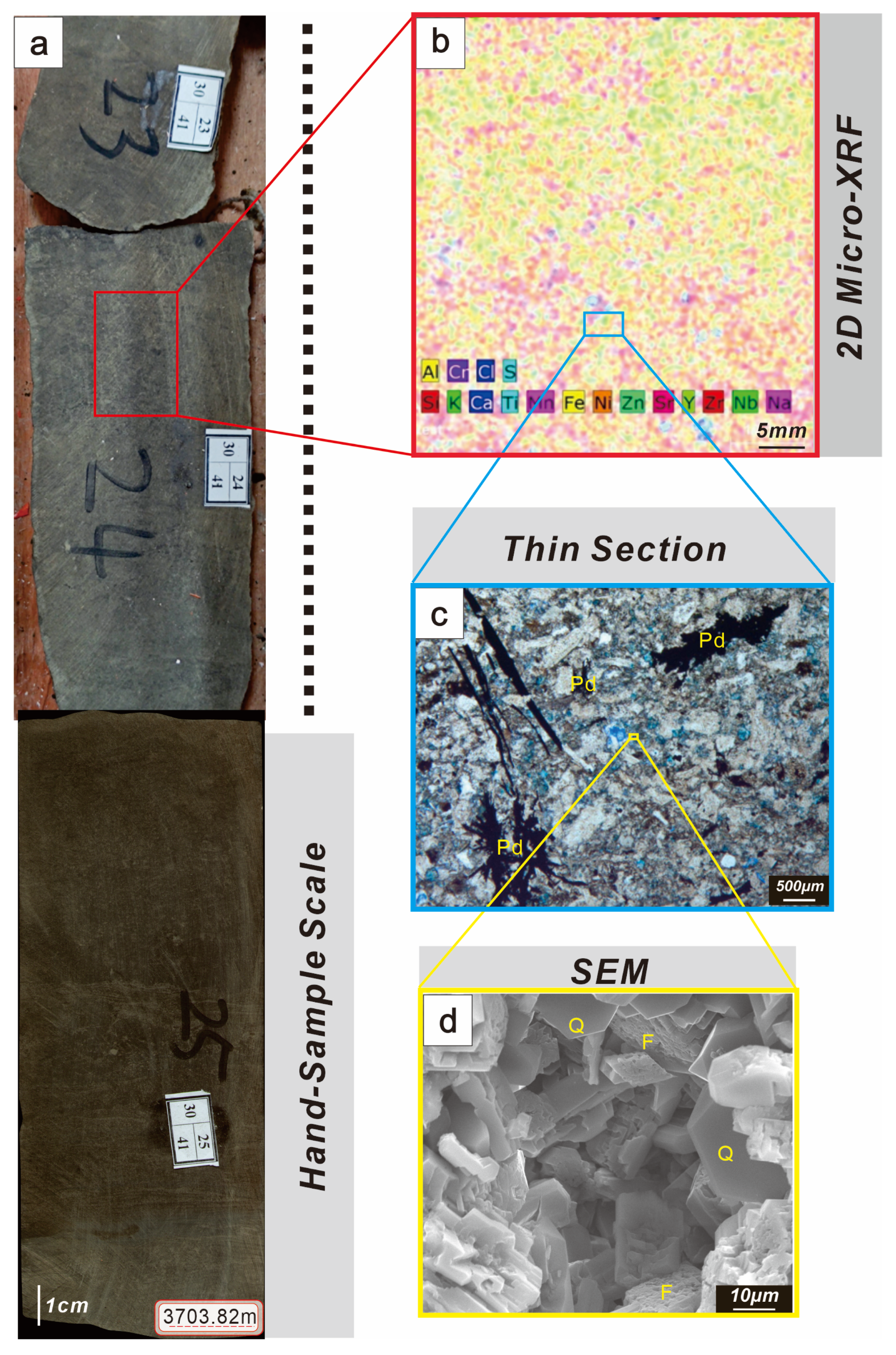
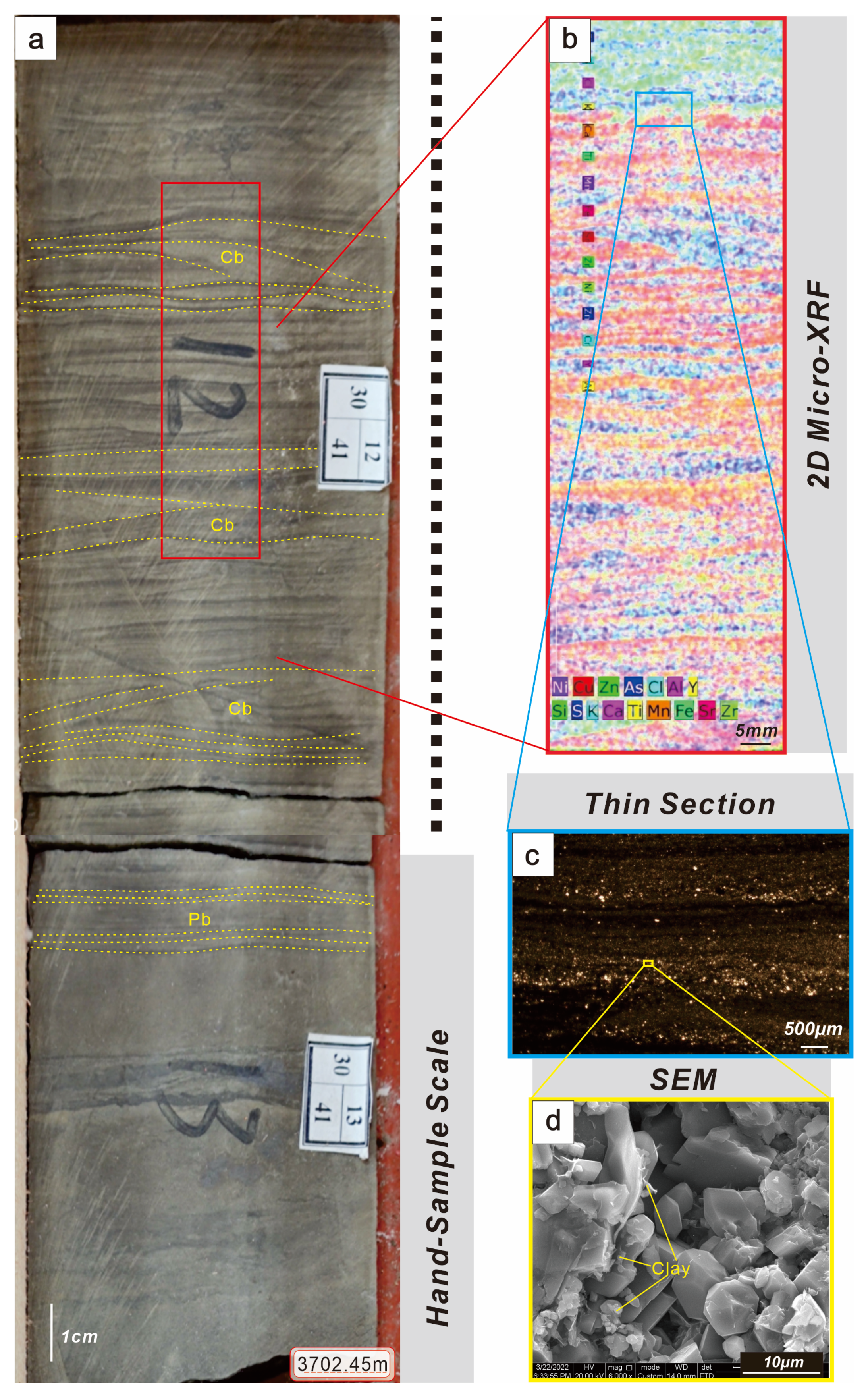
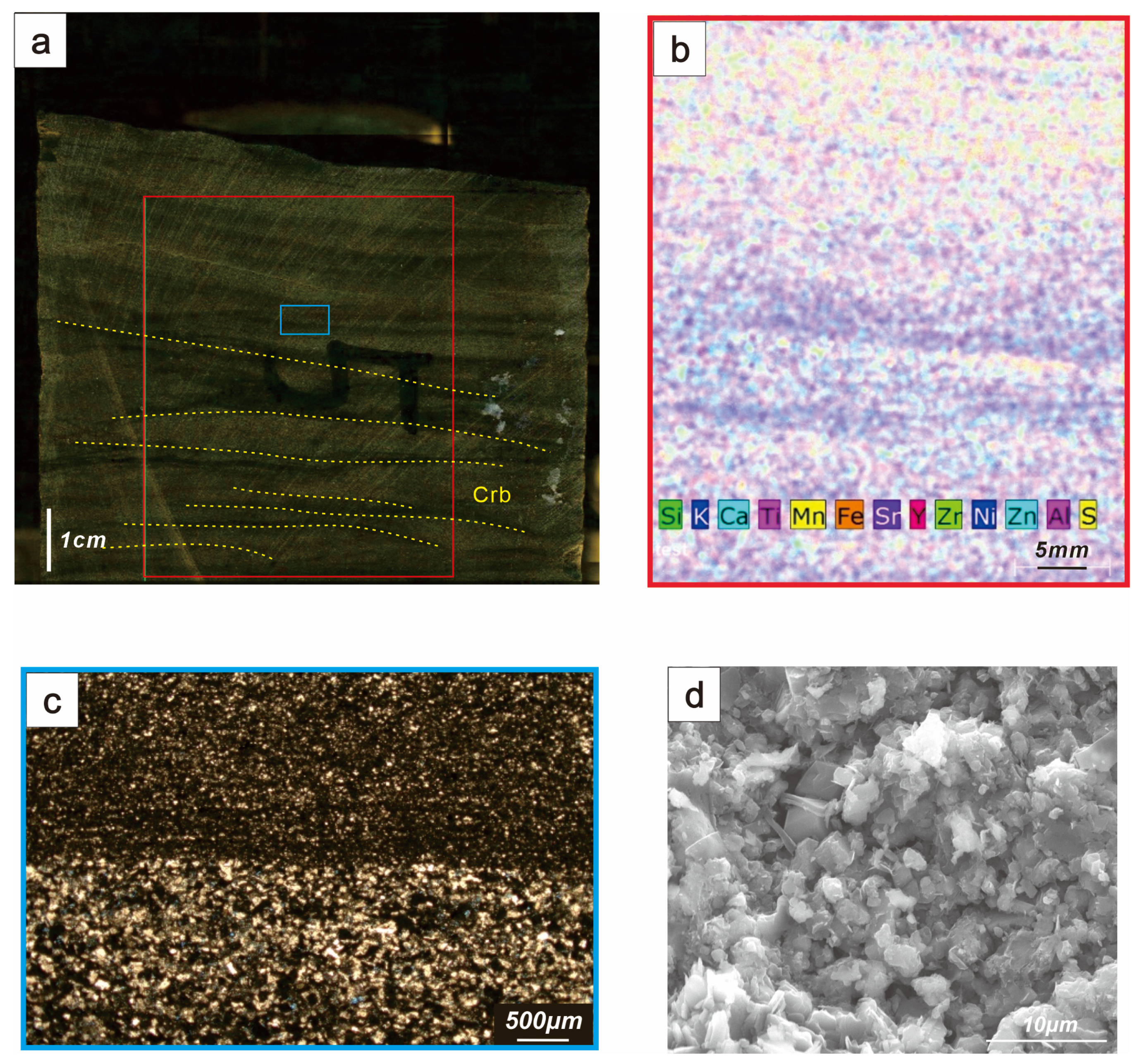
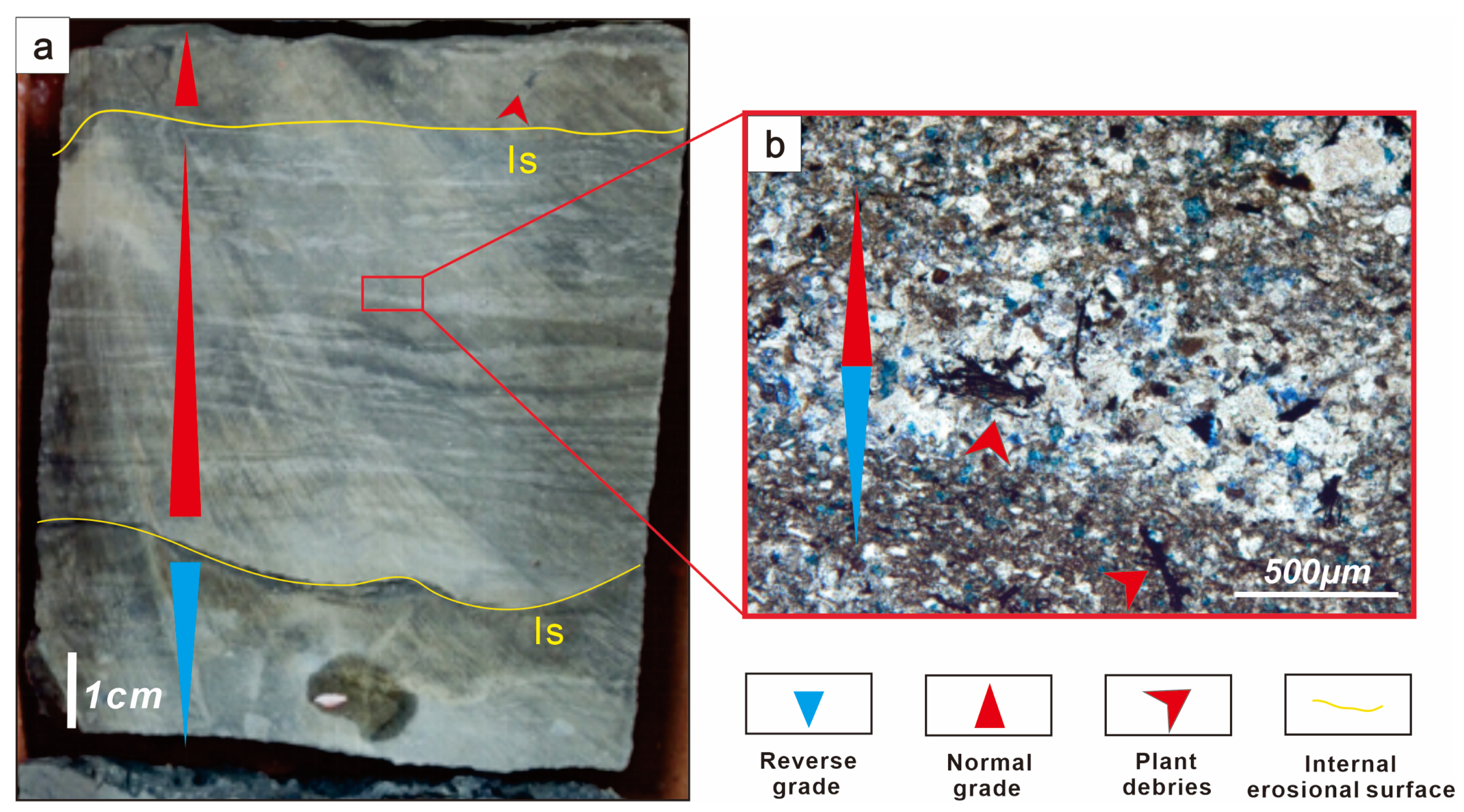
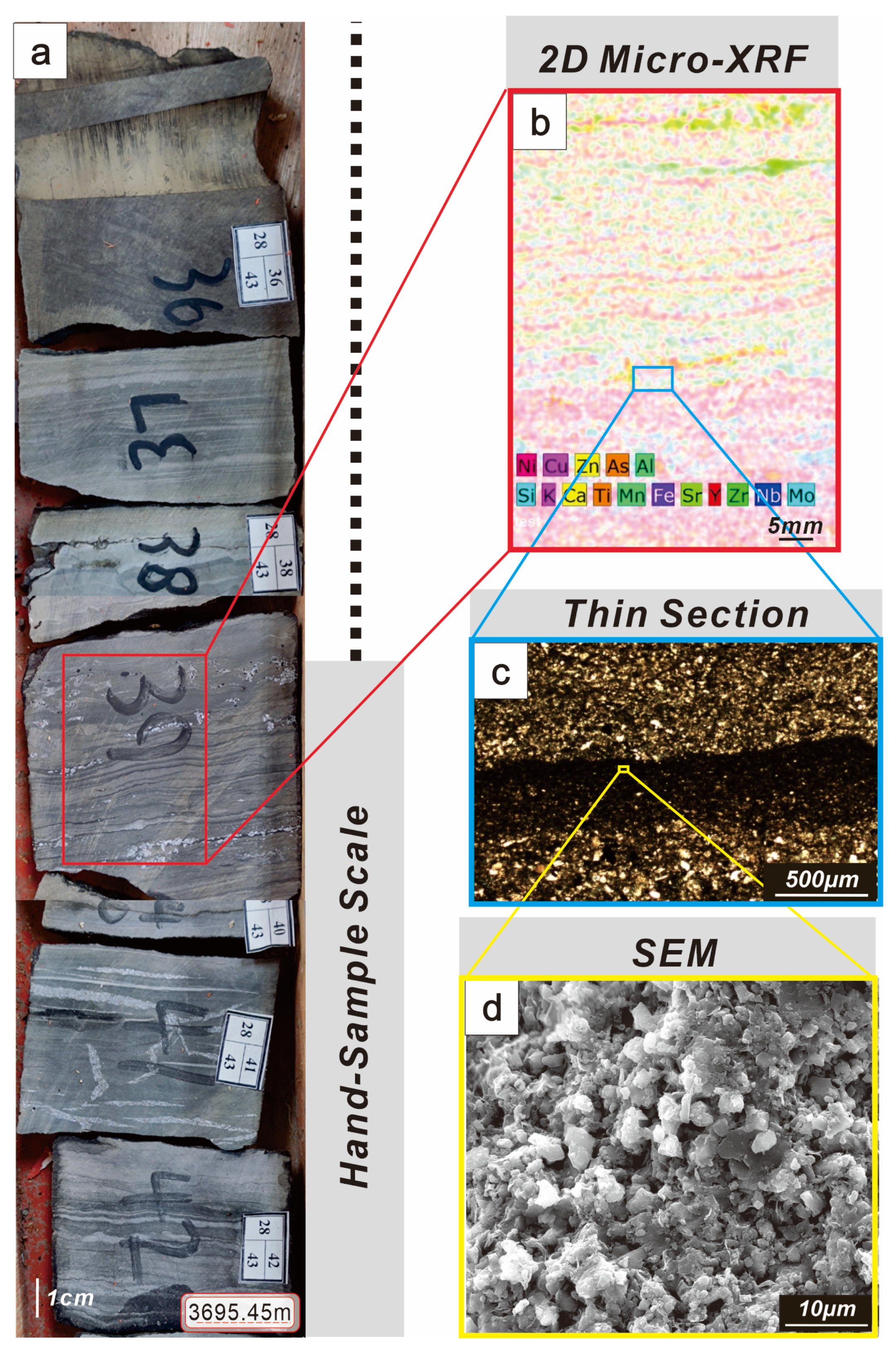

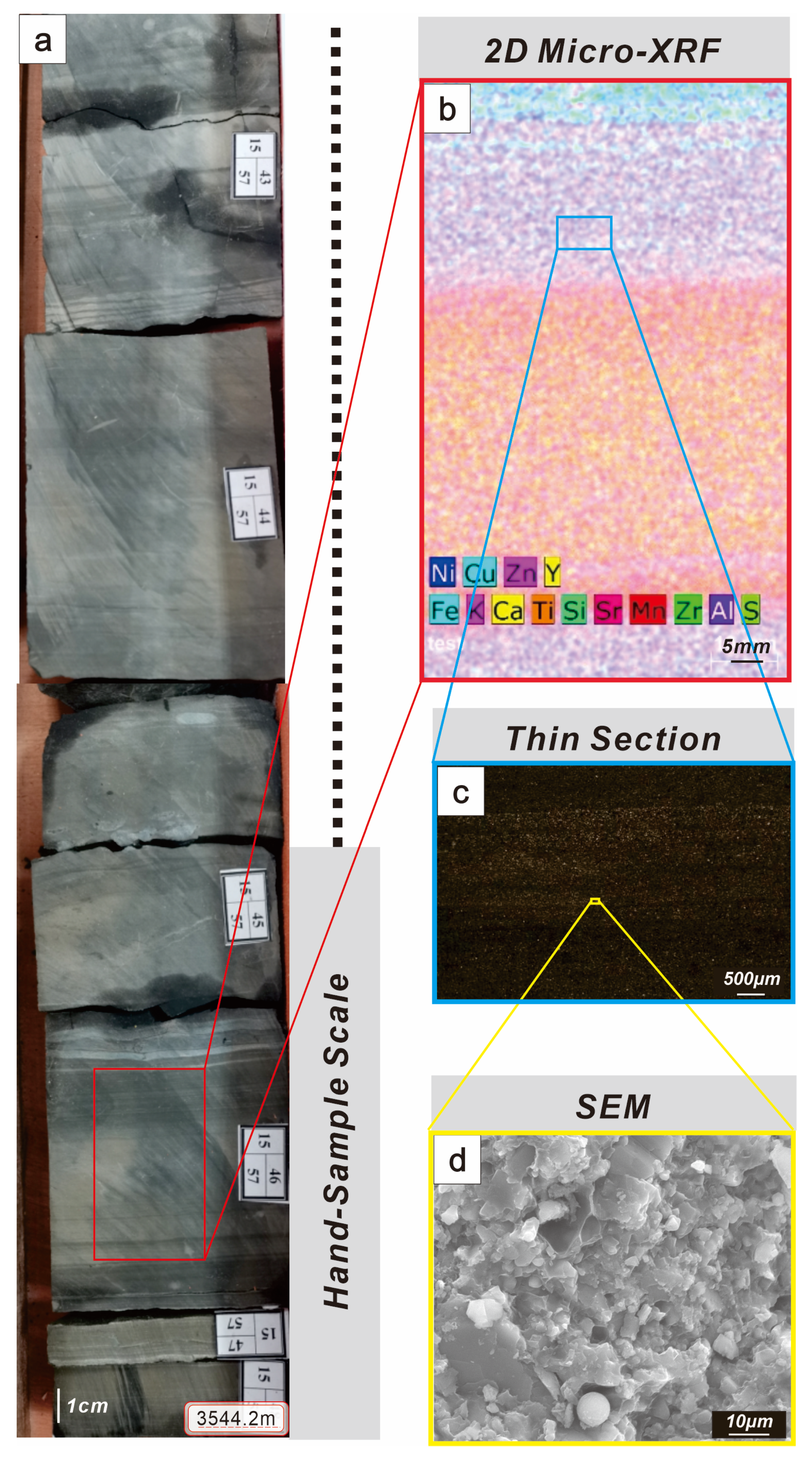

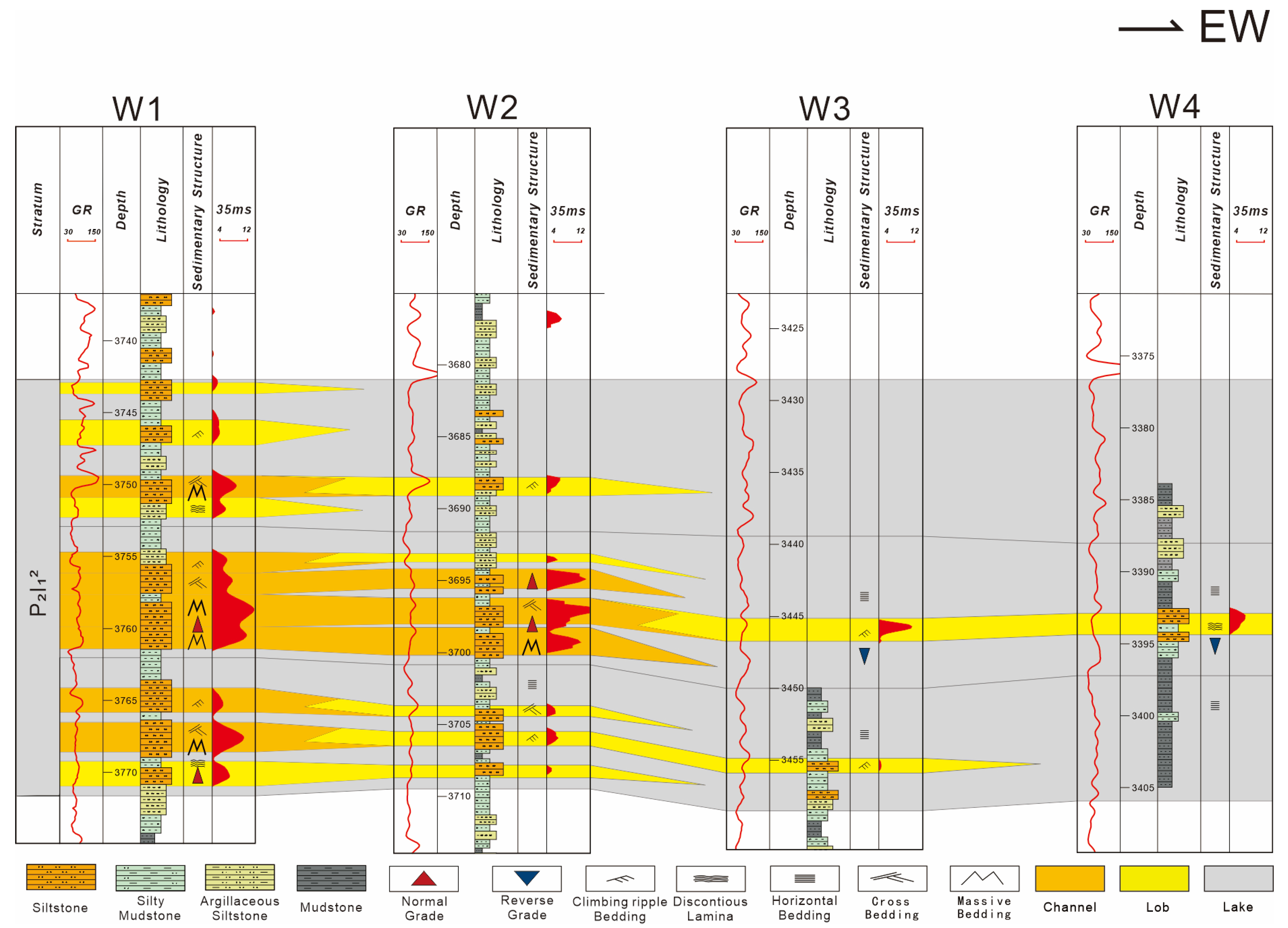
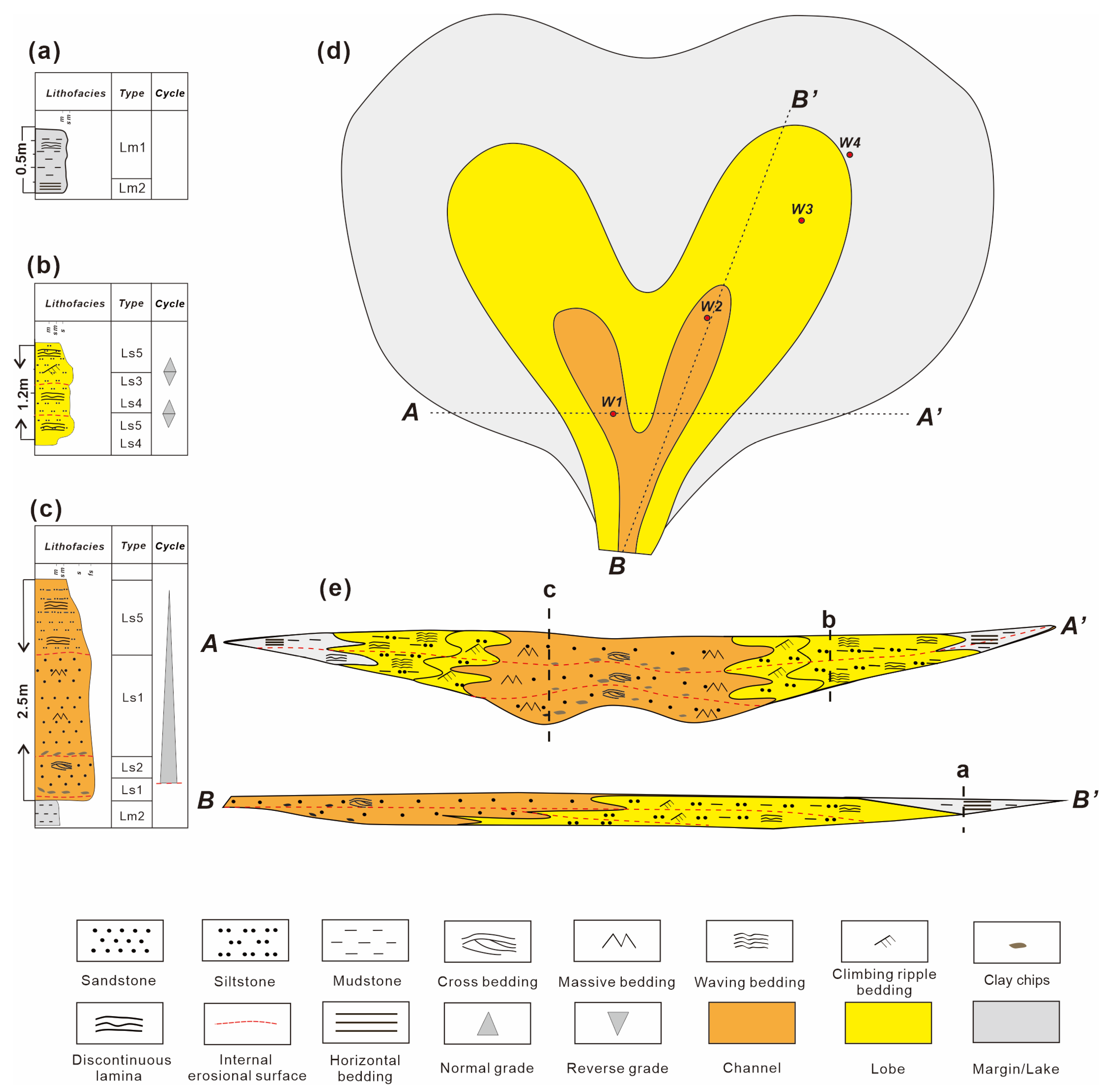

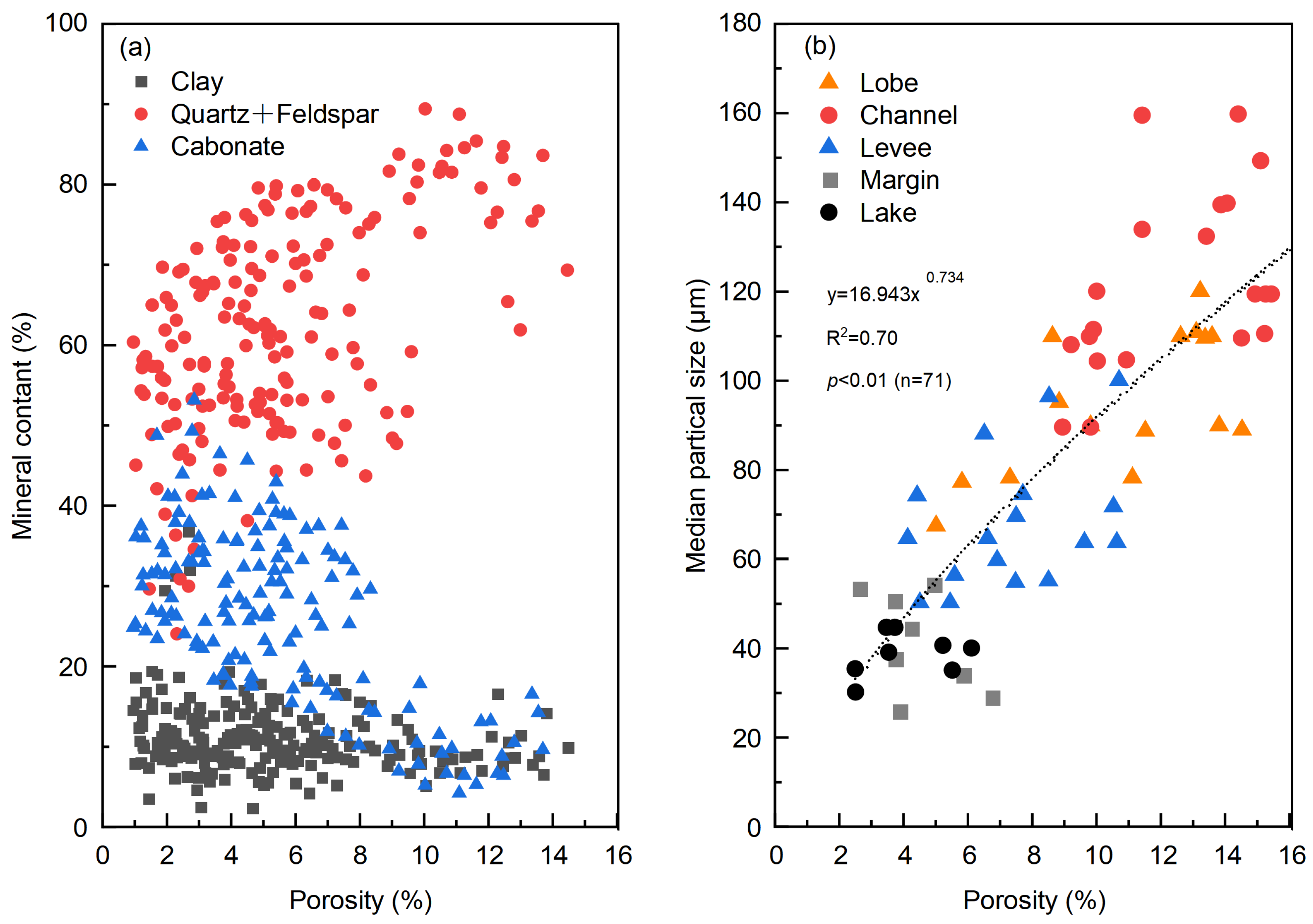

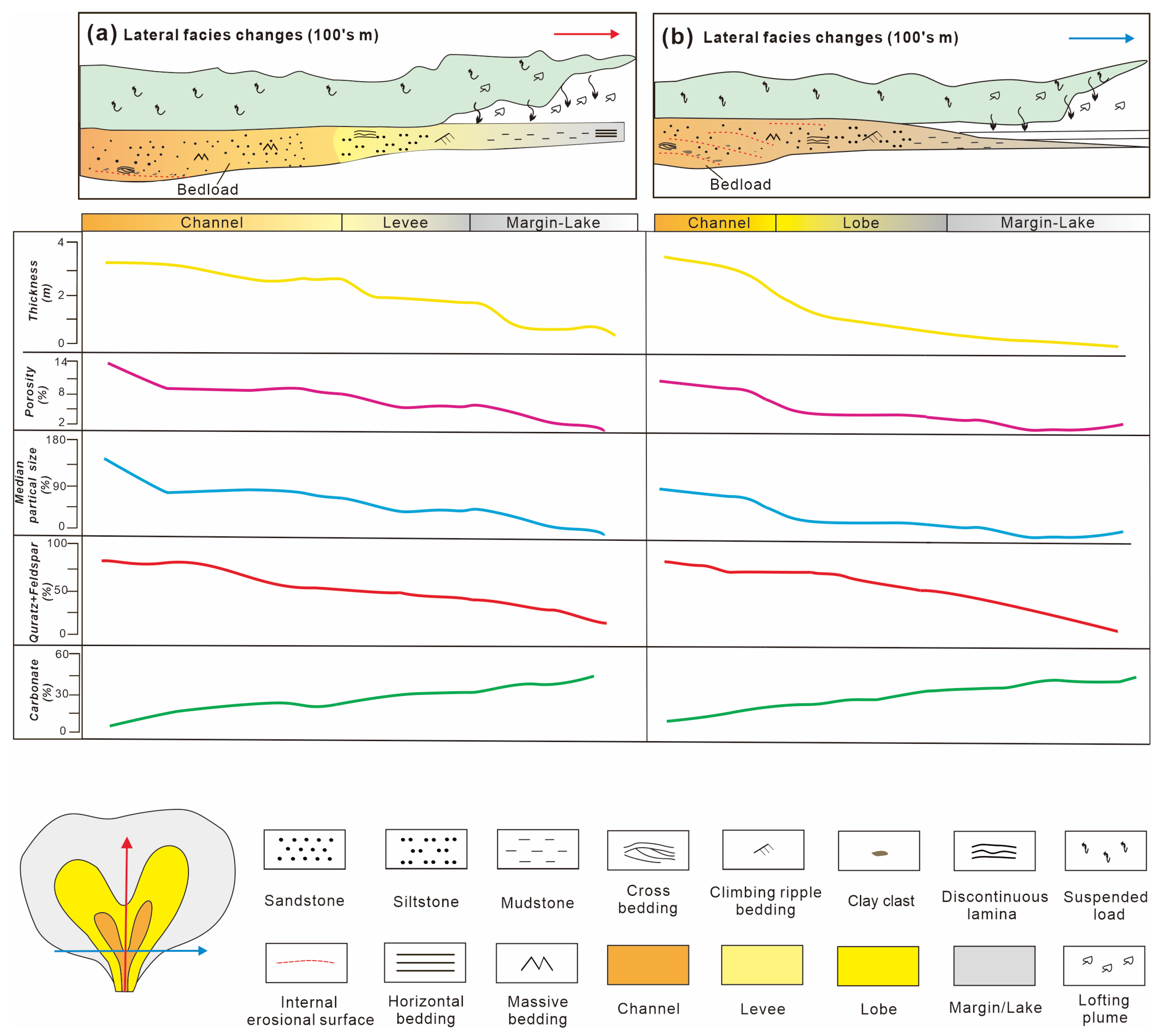
| Well | Type | Completion Elevation (m) | Final Drilling Depth (m) | Lucaogou Formation Depth (m) | Thickness (m) | Number of Cores | |
|---|---|---|---|---|---|---|---|
| Top | Bottom | ||||||
| W1 | Vertical well | 615.65 | 3930 | 3583.8 | 3840.0 | 256.2 | 340 |
| W2 | Vertical well | 607.55 | 3845 | 3520.8 | 3780.0 | 259.2 | 422 |
| W3 | Vertical well | 602.94 | 3565 | 3278.0 | 3525.0 | 247.0 | 362 |
| W4 | Vertical well | 602.57 | 3488 | 3227.2 | 3471.0 | 243.8 | 180 |
Disclaimer/Publisher’s Note: The statements, opinions and data contained in all publications are solely those of the individual author(s) and contributor(s) and not of MDPI and/or the editor(s). MDPI and/or the editor(s) disclaim responsibility for any injury to people or property resulting from any ideas, methods, instructions or products referred to in the content. |
© 2025 by the authors. Licensee MDPI, Basel, Switzerland. This article is an open access article distributed under the terms and conditions of the Creative Commons Attribution (CC BY) license (https://creativecommons.org/licenses/by/4.0/).
Share and Cite
Lian, Y.; Zhang, L.; Chen, X.; Tao, X.; Deng, Y.; Li, P. Multiscale Characteristics and Controlling Factors of Shale Oil Reservoirs in the Permian Lucaogou Formation (Jimusaer Depression, Junggar Basin, NW China). Minerals 2025, 15, 438. https://doi.org/10.3390/min15050438
Lian Y, Zhang L, Chen X, Tao X, Deng Y, Li P. Multiscale Characteristics and Controlling Factors of Shale Oil Reservoirs in the Permian Lucaogou Formation (Jimusaer Depression, Junggar Basin, NW China). Minerals. 2025; 15(5):438. https://doi.org/10.3390/min15050438
Chicago/Turabian StyleLian, Yang, Liping Zhang, Xuan Chen, Xin Tao, Yuhao Deng, and Peiyan Li. 2025. "Multiscale Characteristics and Controlling Factors of Shale Oil Reservoirs in the Permian Lucaogou Formation (Jimusaer Depression, Junggar Basin, NW China)" Minerals 15, no. 5: 438. https://doi.org/10.3390/min15050438
APA StyleLian, Y., Zhang, L., Chen, X., Tao, X., Deng, Y., & Li, P. (2025). Multiscale Characteristics and Controlling Factors of Shale Oil Reservoirs in the Permian Lucaogou Formation (Jimusaer Depression, Junggar Basin, NW China). Minerals, 15(5), 438. https://doi.org/10.3390/min15050438





